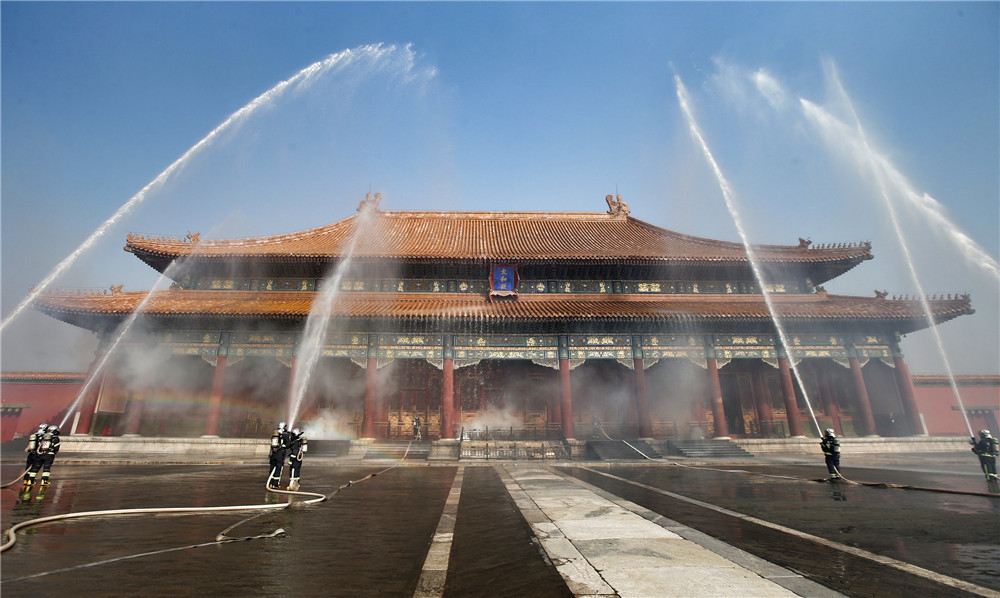


Drills are staged frequently at the Palace Museum in Beijing, where a team is stationed by the east gate to keep watch for fire in turn 24 hours a day. LIU CHANG/FOR CHINA DAILY
Urgent situations
On Sept 7, four days after the inferno in Rio, the State Administration of Cultural Heritage issued a notice urging museums nationwide to learn from the Brazilian blaze and improve awareness of protecting their collections.
The notice instructed museums to check their fire alarms, investigate whether their power lines are out of date, assign personnel to supervise fire prevention, and include this work in an overall evaluation system.
Devastating fires at Chinese museums are not common, the most recent major accident being a fire in 1994 at a museum in Jilin city, Northeast China's Jilin province. Two lives and thousands of cultural relics were lost.
However, a conference held by the State Administration of Cultural Heritage and the Ministry of Emergency Management on Sept 13 gave little room for optimism.
Liu Yuzhu, director of the administration, said: "Though big museums in the country generally do well in preventing fire, many smaller institutions lack the personnel to maintain and manage relevant facilities. Small fires are common.
"Ancient Chinese architecture is mainly constructed from wood and earth, which creates huge difficulties for protection," he said.
Liu added that 41 fires have occurred at key national-level cultural heritage sites since 2010.
A comprehensive survey carried out recently by the administration found that half of the 4,000 national-level key cultural heritage sites have potential fire hazards.
Liu also said that a wider investigation of 230,000 museums, heritage sites and cultural relics preservation institutions had found 21,000 safety breaches, with 41 percent of them related to fire prevention.
Huang Ming, deputy minister of emergency management, has called for a more complete operating system to be established at museums, adding that about 60 percent of fires are caused by faulty power supplies.
"Museum directors should check facilities more often. They should know their institutions like their own front yard."
He said new fire alarm technologies, based on digital platforms such as the internet of things, will be developed to keep a close eye on cultural heritage.
"Fire alarms are the lifelines of all cultural relics," Huang said. "We have to keep a tight grip on safety at key sites."
 |

 Award-winning photos show poverty reduction achievements in NE China's Jilin province
Award-winning photos show poverty reduction achievements in NE China's Jilin province People dance to greet advent of New Year in Ameiqituo Town, Guizhou
People dance to greet advent of New Year in Ameiqituo Town, Guizhou Fire brigade in Shanghai holds group wedding
Fire brigade in Shanghai holds group wedding Tourists enjoy ice sculptures in Datan Town, north China
Tourists enjoy ice sculptures in Datan Town, north China Sunset scenery of Dayan Pagoda in Xi'an
Sunset scenery of Dayan Pagoda in Xi'an Tourists have fun at scenic spot in Nanlong Town, NW China
Tourists have fun at scenic spot in Nanlong Town, NW China Harbin attracts tourists by making best use of ice in winter
Harbin attracts tourists by making best use of ice in winter In pics: FIS Alpine Ski Women's World Cup Slalom
In pics: FIS Alpine Ski Women's World Cup Slalom Black-necked cranes rest at reservoir in Lhunzhub County, Lhasa
Black-necked cranes rest at reservoir in Lhunzhub County, Lhasa China's FAST telescope will be available to foreign scientists in April
China's FAST telescope will be available to foreign scientists in April